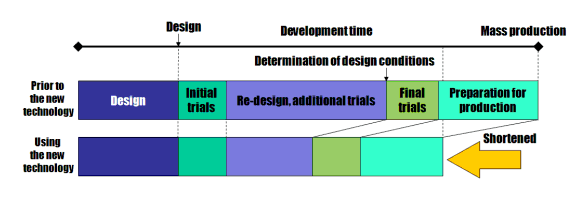Sumitomo Metals Develops New Analytic Technology
for Automobile Collision Simulation, Working Together with
Mazda Motor Corporation and Steelmaker Corus
2009.06.22
- Sumitomo Metal Industries, Ltd.
In a joint effort with Corus, the British and Dutch steel company, Sumitomo Metal Industries has succeeded in developing simulation technology that can greatly reduce the time required for designing the body of new automobiles. The effectiveness of the technology has been validated in tests conducted with Mazda Motor Corporation. This advance will reduce costs by shortening the time period required for design and development.
1. Background of the new technology
Simulation of collisions, using quantitative analysis methods, is essential for the designing of safe, economical motor vehicles. In the past, the general practice was to perform simulation based on the mechanical properties of the materials before they were formed, but the process of formation such as presswork changes these properties. For this reason, the result of those tests could not reflect the material hardening and thinning caused by press forming. There also was a limitation in that the final shape of part was not the same as determined by calculations at the design stage, because of springback* and heat distortion.
As a result, the information obtained through simulation varied from that which was obtained through collision tests, requiring redesign and modification of prototypes, that combined to push up costs. Recently, body parts have come to be made from thin, high-tensile steel, as a means of lowering fuel consumption by reducing vehicle weight. But when the steel sheet is very thin, even a minute change in its thickness alters analysis results considerably, and this made it even more difficult to obtain usable data by means of traditional methods of analysis. As a result, the design modification and the making of prototypes have to be done more and more times than in the past.
2. About the development
In place of the traditional method of simulation wherein the starting point was the mechanical properties of the material prior to press forming, the new technology takes into consideration the properties of the material, the thickness of the sheet, and change in its shape, to simulate the entire process from the original materials to press forming to status as an installed part, and finally the simulated collision. This is break-through technology, that greatly improves the precision of the analysis. By enabling the simulation to reflect changes resulting from press forming the original material, it has become possible to undertake high-precision analysis of the very thin sheets that are in demand today.
To verify the efficacy of the technology, a drop weight test equipment** was used, with parts designed by Mazda Motor using this technology, confirming the results obtained by simulation were accurate.
3. Effects
Design of automotive bodies can be shortened considerably by use of this technology. It is believed that the new technology deserves to become the gold standard for analysis of the effects of vehicle collisions, and can contribute to the improvement of vehicle and occupant safety, as well as to reduction of production costs.
Effects of the technology are shown schematically as follows.

Terminology
Springback: After steel is processed in a press, residual force in the metal causes the material to revert, very slightly, to the original form.
Drop weight test equipment: It is the equipment to evaluate ability to absorb collision energy by making a weight fall freely and crashing test material. Differing from an actual collision test, the part is fixed in place; this makes it possible to obtain detailed data.
